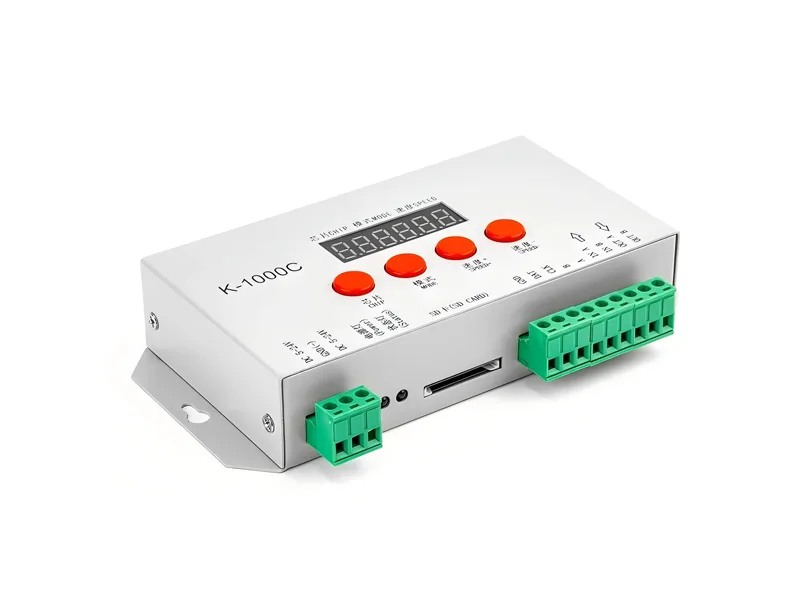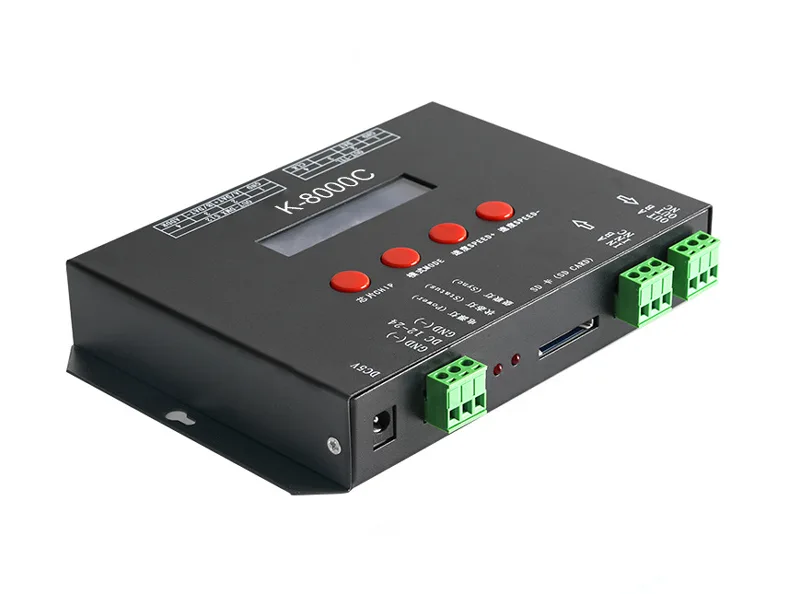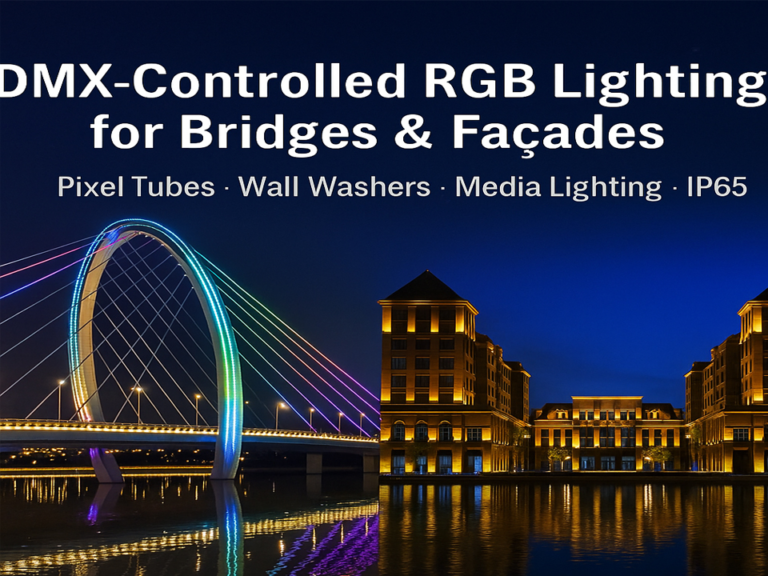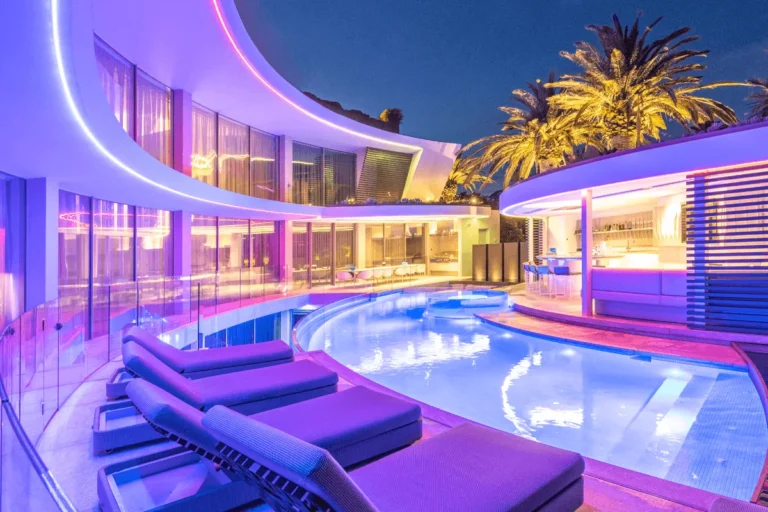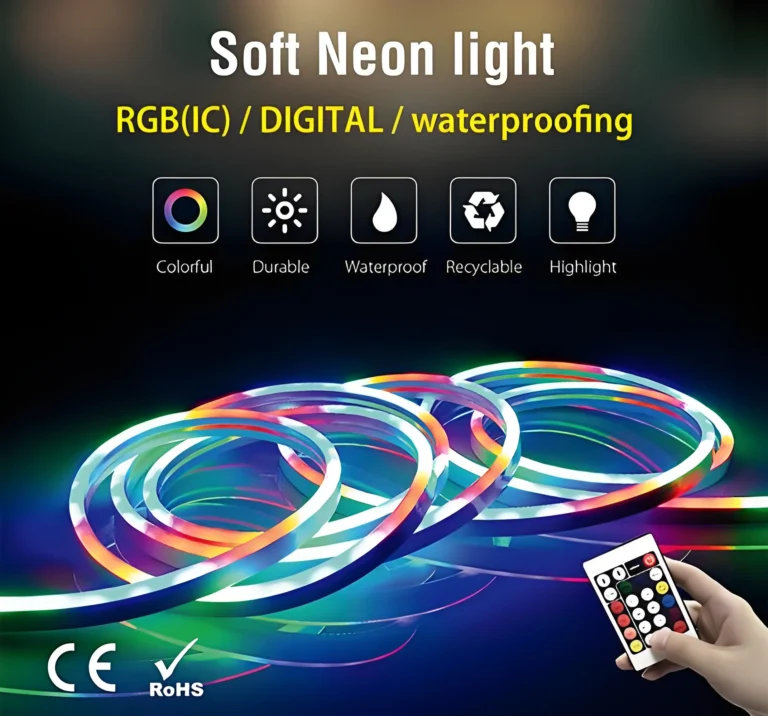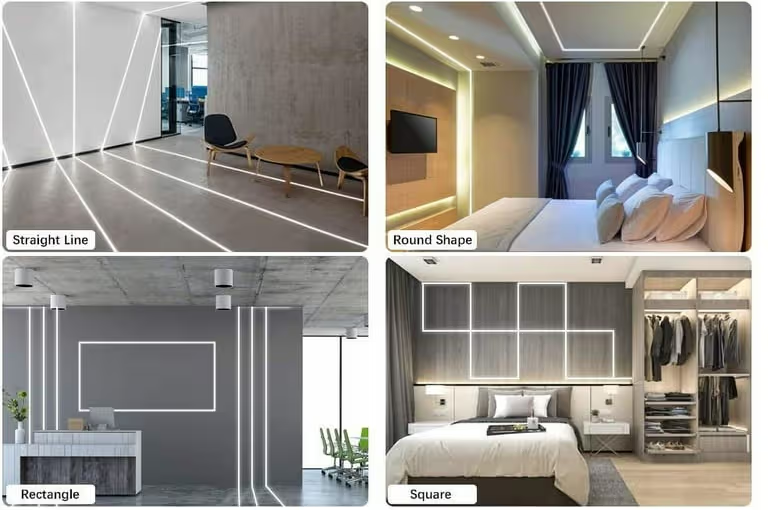ไฟ LED สถาปัตยกรรมรุ่นใหม่กำลังเกิดขึ้น: LED Neon Flex สามารถพอดีกับสกินอาคารที่มีรูปทรงได้อย่างสมบูรณ์แบบ ใช้พลังงานน้อยกว่านีออน 85% และด้วยระบบควบคุมอัจฉริยะ DMX512 การผสมผสานสี 2.56 ล้านชุดสามารถรับรู้ได้ในอาคารเดียว
เอฟเฟกต์แสงเกลียวของ Shanghai Center Tower และการแสดงแสงพิกเซลของ Guangzhou Tower ยืนยันความเป็นไปได้ที่ไม่มีที่สิ้นสุดของแสงดิจิตอล สิ่งที่น่าสังเกตมากกว่านั้นคือการรวมเทคโนโลยี IoT เข้าด้วยกัน ระบบไฟส่องสว่างของอาคาร Ping ในเซินเจิ้นสามารถตอบสนองต่อข้อมูล PM2.5 ได้แบบเรียลไทม์ และแสดงภาพคุณภาพอากาศในเมืองด้วยแสงและเงา แสงอัจฉริยะเปลี่ยนส่วนหน้าของอาคารให้เป็นผ้าใบดิจิทัล ซึ่งสามารถตั้งโปรแกรมให้สลับไปมาระหว่างฉากต่างๆ เช่น การเฉลิมฉลองวันหยุดและแคมเปญการบริการสาธารณะได้อย่างราบรื่น แสงไฟในป่าแนวตั้งของมิลานยังเลียนแบบจังหวะการสังเคราะห์แสงของต้นไม้ ทำให้อาคารเป็นสิ่งมีชีวิต
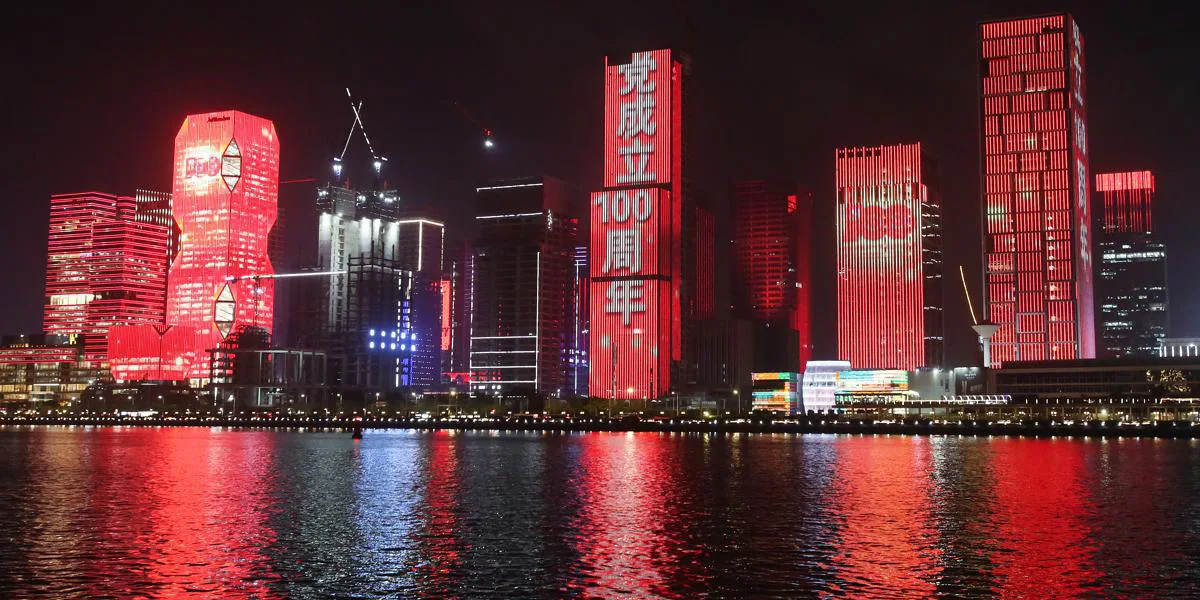
ในการออกแบบแสงทางสถาปัตยกรรม ไฟ LED Neon Flex ที่ควบคุมโดย DMX กำลังปรับโฉมสุนทรียศาสตร์เชิงพื้นที่ด้วยความยืดหยุ่นที่เหนือกว่าและการแสดงออกแบบไดนามิก ด้วยโปรโตคอล DMX512 นักออกแบบสามารถควบคุมความสว่าง สี และไดนามิกของแต่ละแถบได้อย่างแม่นยำ ทำให้เกิดความคิดสร้างสรรค์ที่ไม่สิ้นสุดตั้งแต่การหายใจทีละน้อยไปจนถึงจังหวะที่ซับซ้อน คู่มือทางเทคนิคนี้จะวิเคราะห์สถาปัตยกรรมระบบไฟ DMX จุดออกแบบ และการเลือกผลิตภัณฑ์ของอุปกรณ์ทั่วไป ฉันหวังว่าคุณจะอ่านมันเพื่อช่วยคุณและช่วยให้โครงการของคุณใช้งานได้เร็วขึ้น
ข้อดีของโปรโตคอล DMX512 ในแสงอัจฉริยะ
โปรโตคอล DMX512 ให้การควบคุมแสงโดยแสงผ่านช่องอิสระ 512 ช่องซึ่งสามารถขับเคลื่อนพารามิเตอร์หลายมิติได้อย่างแม่นยำเช่นสีความสว่างเอฟเฟกต์ไดนามิก ฯลฯ เพื่อตอบสนองความต้องการที่เข้มงวดของเอฟเฟกต์แสงที่ซับซ้อนในฉากเช่นขั้นตอนและอาคาร
ความเร็วในการตอบสนองเป็นมิลลิวินาทีช่วยให้มั่นใจได้ว่าการทำงานแบบซิงโครไนซ์ของหลอดไฟขนาดใหญ่และโคมไฟขนาดใหญ่ ซึ่งเหมาะอย่างยิ่งสำหรับการใช้งานแบบโต้ตอบแบบเรียลไทม์ เช่น การไล่ล่าแสงแบบไดนามิกและการเชื่อมโยงเพลง การนำสถาปัตยกรรมมาสเตอร์-สเลฟและการส่งสัญญาณที่แตกต่างกันมาใช้ รองรับอุปกรณ์ได้มากถึง 32 เครื่องในซีรีส์และโหนดหลายพันโหนด ให้ความสามารถในการปรับขนาดของระบบได้ดีเยี่ยม
อินเทอร์เฟซที่ได้มาตรฐานและความเข้ากันได้ที่แข็งแกร่งช่วยให้เข้าถึงเครื่องหรี่ไฟ คอนโทรลเลอร์ และหลอดไฟอัจฉริยะประเภทต่างๆ ได้อย่างราบรื่น รวมกับคุณสมบัติป้องกันการติดขัดของชั้นทางกายภาพ RS485 เพื่อรักษาการส่งผ่านที่เสถียรในสภาพแวดล้อมแม่เหล็กไฟฟ้าที่ซับซ้อนของโครงการ
ลักษณะทางเทคนิคเหล่านี้ทำให้ DMX เป็นโซลูชันการควบคุมที่ต้องการในด้านการแสดงขนาดใหญ่ ภูมิทัศน์ของธีม อาคาร อาคาร และแสงอื่นๆ ระดับมืออาชีพ
ทำไมต้องใช้ LED Neon Flex สำหรับแสงสถาปัตยกรรม?

การใช้ แถบนีออนแบบยืดหยุ่น LED สำหรับแสงสถาปัตยกรรม มีข้อดีหลายประการ อย่างแรกเลย ความยืดหยุ่นอันสุดยอดสามารถพอดีกับพื้นผิวโค้งที่ซับซ้อนหรือโครงสร้างที่มีรูปร่าง เข้าใจโครงร่างของอาคาร การตกแต่งด้านหน้า โดมเซอร์ราวด์ และการออกแบบที่สร้างสรรค์อื่นๆ ได้อย่างง่ายดาย ทำให้แสงศิลป์มีพลังในการแสดงออกที่มากขึ้น
แถบแสงนีออนใช้การออกแบบโมดูลาร์ซึ่งสามารถตัดและต่อได้อย่างอิสระเพื่อให้พอดีกับขนาดต่าง ๆ ของสถานการณ์การติดตั้งซึ่งช่วยลดความยากในการก่อสร้างได้อย่างมาก
ประการที่สองแหล่งกำเนิดแสง LED มีประสิทธิภาพการส่องสว่างสูงและลักษณะการใช้พลังงานต่ำด้วยระบบลดแสงอัจฉริยะประสิทธิภาพพลังงานเมื่อเทียบกับแสงแบบดั้งเดิมเพื่อเพิ่มมากกว่า 50% และการสร้างความร้อนต่ำช่วยลดภาระความร้อนของอาคาร
ประการที่สาม รองรับการผสมแสงแบบ RGB แบบเต็มสีและการเขียนโปรแกรมแบบไดนามิก และให้สีไล่ระดับสี ไฟวิ่ง การเชื่อมโยงเพลง และเอฟเฟกต์อื่นๆ ผ่านโปรโตคอล DMX หรือไร้สาย ซึ่งช่วยเพิ่มการโต้ตอบและความรู้สึกทางเทคโนโลยีของฉากกลางคืนทางสถาปัตยกรรม
นอกจากนี้ชั้นนอกของแถบยืดหยุ่นยังห่อหุ้มด้วยซิลิโคนหรืออีพอกซีเรซินที่มีระดับกันน้ำสูงถึง IP67 หรือสูงกว่าความต้านทานสภาพอากาศที่แข็งแกร่งสามารถปรับตัวให้เข้ากับความแตกต่างของอุณหภูมิกลางแจ้งฝนและสภาพแวดล้อมอัลตราไวโอเลตและอายุการใช้งานได้นานถึง 50,000 ชั่วโมงซึ่งช่วยลดค่าใช้จ่ายในการบำรุงรักษาได้อย่างมาก ลักษณะของแหล่งจ่ายไฟแรงดันต่ำ (12/24 V) ยังช่วยเพิ่มความปลอดภัยทางไฟฟ้า ทำให้เป็นโซลูชันที่ต้องการสำหรับโครงการแสงสถาปัตยกรรมสมัยใหม่
ระบบ DMX512 คืออะไร?
DMX512 (Digital Multiplex 512) เป็นมาตรฐานการควบคุมแบบดิจิตอลที่ใช้กันอย่างแพร่หลายในด้านแสงเวที แสงสถาปัตยกรรม ฯลฯ มันตระหนักถึงการควบคุมที่แม่นยำของอุปกรณ์ติดตั้งผ่านสัญญาณดิจิทัล หลักการสำคัญคือการส่งคำสั่งควบคุมโดยการสื่อสารแบบอนุกรม และแต่ละลิงก์สัญญาณ DMX ประกอบด้วยตัวควบคุมหลัก (เช่น คอนโซลหรี่ไฟ) และอุปกรณ์รองหลายตัว (อุปกรณ์ติดตั้ง เครื่องหรี่ไฟ ฯลฯ) ระบบนี้ใช้มาตรฐาน RS-485 Physical Layer โดยใช้เทคโนโลยีการส่งสัญญาณแบบดิฟเฟอเรนเชียล พร้อมความสามารถในการป้องกันการติดขัดที่แข็งแกร่งและระยะการส่งสูงสุดถึง 1200 เมตร (จำเป็นต้องขยายตัวซ้ำ)
แต่ละเฟรมข้อมูล DMX ประกอบด้วยช่องควบคุมอิสระ 512 ช่อง แต่ละช่องจะสอดคล้องกับข้อมูล 8 บิต (ช่วงค่า 0-255) ซึ่งสามารถปรับความสว่าง สี แทร็กการเคลื่อนไหว และพารามิเตอร์อื่นๆ ของหลอดไฟ ตัวอย่างเช่น อุปกรณ์ติดตั้ง LED RGB มักจะใช้ช่องสัญญาณ 3 ช่อง (ช่องละ 1 ช่องสำหรับสีแดง สีเขียว และสีน้ำเงิน) และสามารถรับคำสั่งที่เกี่ยวข้องได้หลังจากตั้งค่าหมายเลขช่องเริ่มต้นผ่านตัวเข้ารหัสที่อยู่ คอนโทรลเลอร์จะส่งแพ็กเก็ตข้อมูลแบบวนรอบที่อัตราสูงสุด 250 kbps รีเฟรชประมาณ 44 ครั้งต่อวินาทีเพื่อให้แน่ใจว่าการเปลี่ยนแปลงแสงแบบเรียลไทม์ ระบบรองรับโครงสร้างอนุกรมแบบโซ่ สายเดียวสามารถควบคุมอุปกรณ์ได้ถึง 32 เครื่อง และสามารถขยายตัวแยกไปยังโหนดหลายพันโหนดเพื่อตอบสนองความต้องการของโครงการแสงสว่างขนาดใหญ่
องค์ประกอบของระบบ DMX512 ส่วนใหญ่ประกอบด้วยส่วนต่อไปนี้:
คอนโซล DMX: อุปกรณ์หลักที่ส่งสัญญาณควบคุม (เช่น คอนโซลแสงหรือซอฟต์แวร์)
ตัวรับสัญญาณ DMX: โมดูลถอดรหัสในอุปกรณ์ติดตั้งหรืออุปกรณ์อื่น ๆ การรับและดำเนินการคำสั่ง
สาย DMX: สายคู่บิดแบบพิเศษแบบมีฉนวนหุ้ม, พันธมิตรที่มีขั้วต่อ XLR 5 พินหรือ 3 พิน
ตัวต้านทานสิ้นสุด: มีการติดตั้งตัวต้านทาน (โดยปกติคือ 120 Ω) ที่ส่วนท้ายของห่วงโซ่สัญญาณเพื่อป้องกันสัญญาณรบกวนการสะท้อนสัญญาณ
คุณสมบัติของเทปนีออน DMX512 คืออะไร?
- แถบนีออนพิกเซล DMX ประกอบด้วยเม็ดบีด LED ที่ควบคุมอย่างอิสระหลายเม็ด (พิกเซล) แต่ละพิกเซลสามารถปรับสีได้ (เช่น RGB/RGBW) และความสว่างเพื่อสร้างรูปแบบไดนามิกหรือเอฟเฟกต์การไล่ระดับสี ไฟ LED แต่ละดวงสามารถตั้งโปรแกรมได้อย่างอิสระเพื่อให้ได้เอฟเฟกต์ภาพเคลื่อนไหวที่ละเอียดอ่อน (เช่น น้ำไหล กะพริบ ซีดจาง)
- เมื่อเทียบกับไฟนีออนแบบดั้งเดิม จะประหยัดพลังงานมากกว่า ทนทาน และรองรับการควบคุมการเขียนโปรแกรม
- แถบนีออน LED ที่ห่อด้วยวัสดุที่ยืดหยุ่นได้ (เช่น ซิลิโคน พีวีซี) สามารถโค้งงอและตัดได้อย่างอิสระเพื่อปรับให้เข้ากับสภาพแวดล้อมการติดตั้งของรูปทรงที่ซับซ้อน (เช่น พื้นผิวโค้ง โครงสร้างโค้ง)
- เกียร์ทางไกล (สูงถึง 1200 เมตร) ความเข้ากันได้สูงและสามารถควบคุมอุปกรณ์ได้หลายเครื่องในเวลาเดียวกัน
- รองรับการแสดงผลความละเอียดสูงเหมาะสำหรับข้อความ รูปแบบ และภาพเคลื่อนไหว
- ส่งคำสั่งผ่านคอนโทรลเลอร์ DMX ซึ่งสามารถซิงโครไนซ์กับอุปกรณ์ให้แสงสว่างบนเวทีอื่นๆ เช่น ไฟหน้าแบบเคลื่อนที่ ไฟเลเซอร์ ฯลฯ เพื่อสร้างเอฟเฟกต์แบบรวมศูนย์
- รองรับการขยายหลายจักรวาลเพื่อตอบสนองความต้องการของการติดตั้งขนาดใหญ่ (เช่น หน้าอาคาร เวทีขนาดใหญ่)
- เกรดกันน้ำสูง ไม่กลัวสภาพแวดล้อมกลางแจ้งที่รุนแรง โดยปกติแล้วจะสูงถึง IP65 หรือ IP67 เหมาะสำหรับการใช้งานในร่มและกลางแจ้ง
- การออกแบบ Cuttable: ปรับความยาวได้ตามต้องการลดความซับซ้อนในการติดตั้ง
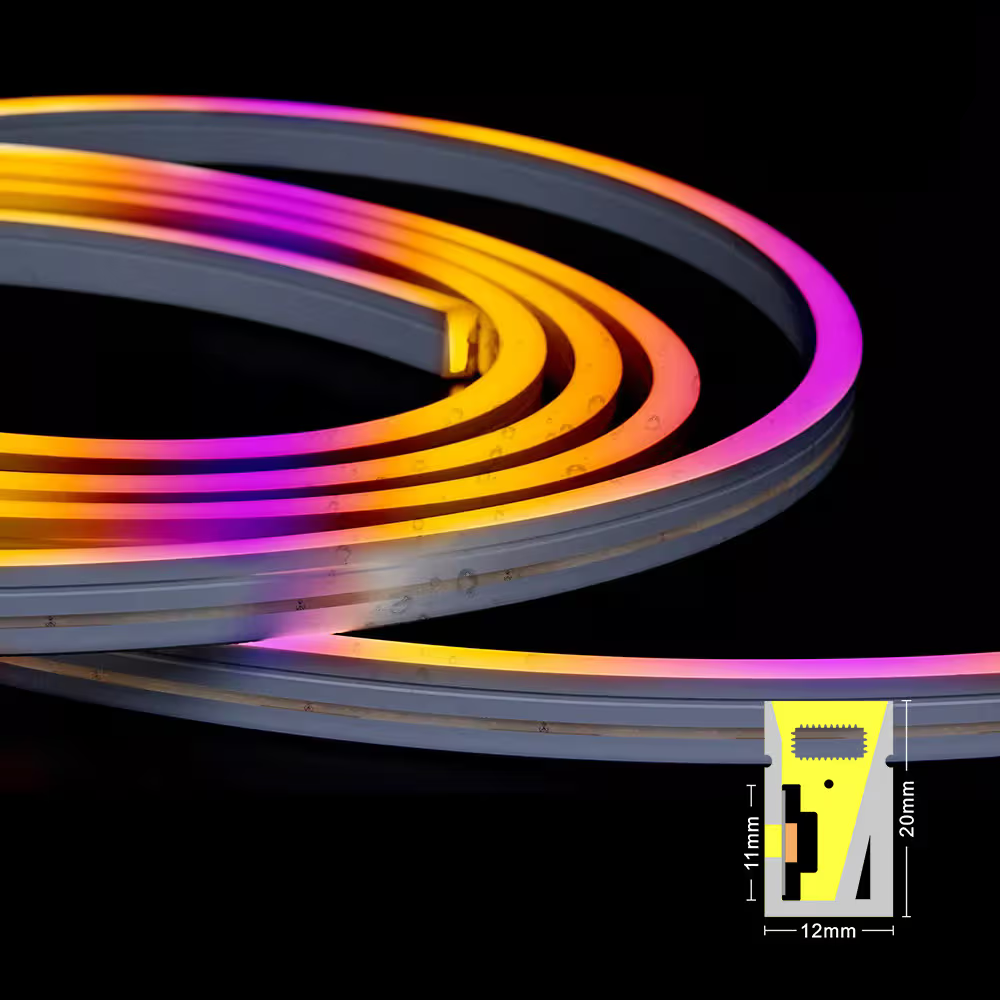
โค้งงอ S1220 ซิลิโคน LED แถบนีออนสำหรับสถาปัตยกรรม, ผนังกระจกและไฟหน้าอาคาร
แรงดันไฟฟ้าขาเข้า: DC24V
วัตต์: 12W/M@RGB, 19W/M@RGBW
จำนวน LED: SMD5050 60LEDs/M
อุณหภูมิสี: RGB/RGBW (2700K-6500K)
ประเภทสัญญาณ: SPI/DMX512
เกรด IP: IP65/IP67
สายเคเบิ้ล: ด้านหน้า
เส้นผ่านศูนย์กลางดัด: 100 มม.
ความยาวตัดได้: 100 มม
ความยาว: 5 เมตร/ม้วน
DMX512 ควบคุมแถบไฟนีออน LED ได้อย่างไร?
ตัวควบคุม DMX512 ส่งคำสั่งไปยังระบบแถบ LED นีออนผ่านสัญญาณดิจิตอล (ตามมาตรฐาน RS-485) สัญญาณจะถูกแยกวิเคราะห์โดยตัวถอดรหัสและจับคู่ข้อมูลช่อง RGB ของแต่ละพิกเซล LED ตามที่อยู่ที่ตั้งไว้เพื่อปรับความสว่าง (0-255) อย่างอิสระ ผ่านการเขียนโปรแกรมของฉากพรีเซ็ตหรือการควบคุมแบบเรียลไทม์เพื่อให้เกิดการไล่ระดับแบบไดนามิก การกะพริบแบบซิงโครไนซ์ และเอฟเฟกต์อื่น ๆ ที่ใช้กับเวที การสร้าง และฉากอื่นๆ เพื่อให้แน่ใจว่าอุปกรณ์หลายเครื่องทำงานร่วมกันและต่อต้านการรบกวน การเชื่อมต่อการควบคุมเฉพาะจะอ้างอิงถึงแผนภาพวงจรต่อไปนี้
DMX512 แผนภาพวงจรการเชื่อมต่อระบบ:

การเลือกอุปกรณ์ควบคุม DMX512
I. DMX512 ต้นแบบ
DMX512 MASTER ส่งสัญญาณของมาตรฐานสากล DMX512/1990 ถึงตัวถอดรหัส DMX512 เพื่อควบคุมไฟ LED สีเดียว, CCT, RGB, RGBW และ RGB + CCT สองอันที่ใช้กันมากที่สุดมีดังนี้:
1. DMX512 คอนโทรลเลอร์แผงสัมผัส: รองรับเอาต์พุต DMX512 พร้อมการหรี่แสงในตัว การปรับอุณหภูมิสี ฟังก์ชันการควบคุม RGB/RGBW และความสามารถในการจัดการโซน (สูงสุด 4 โซน) และรวมโหมดไดนามิกหลายโหมด (เช่น การไล่ระดับสีและการกระโดด) การออกแบบการติดตั้ง 86 ประเภทเหมาะสำหรับสถานการณ์เชิงพาณิชย์หรือที่บ้าน
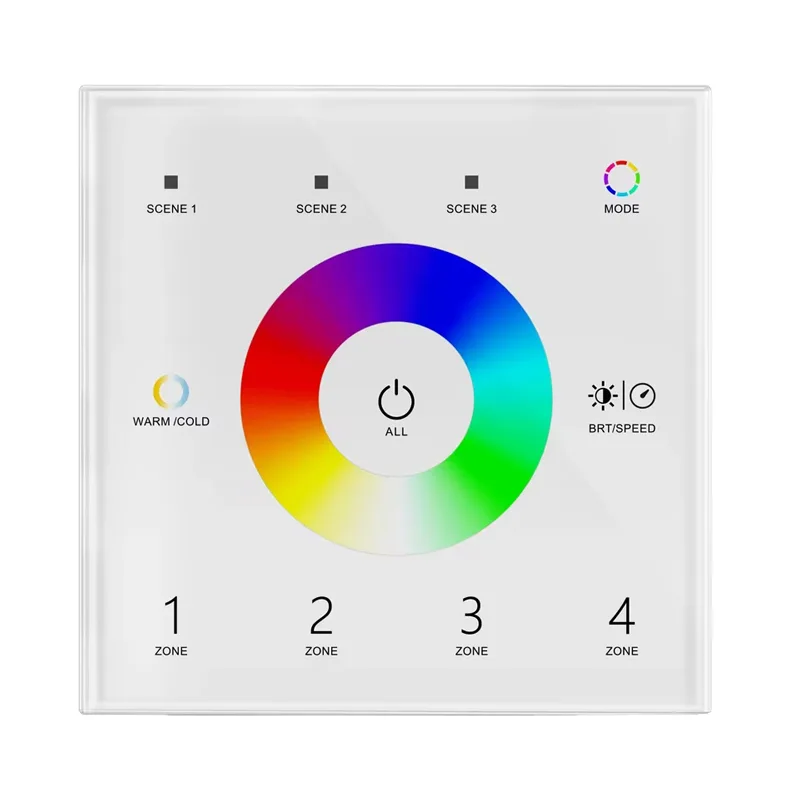
T15 แผงสัมผัส DMX512 แบบติดผนัง
● แผงสัมผัส 4-Zone 1-5 Color DMX512 Master สามารถใช้เป็นรีโมท RF แบบ 4 โซน 1-5 สีได้
● เอาต์พุตสัญญาณ DMX สอดคล้องกับโปรโตคอล DMX512 มาตรฐาน เข้ากันได้กับตัวถอดรหัส DMX จากซัพพลายเออร์ทุกราย
● เมื่อใช้เป็นรีโมท RF แต่ละโซนสามารถควบคุมรีโมทคอนโทรล RF 2.4G หลายตัว ไดรเวอร์ลดแสง หรือหลอดไฟอัจฉริยะ
● มีความไวสูง ความแข็งแรงสูง
ดาวน์โหลดแผ่นข้อมูล T15 ติดผนัง DMX512 แผงสัมผัส
ราคา: 24.98 USD/PCS
2 . DMX512 ตัวควบคุมR: ตัวควบคุม DMX512 เป็นอุปกรณ์หลักที่ใช้สำหรับการควบคุมแบบรวมศูนย์และการควบคุมอุปกรณ์แสงบนเวทีและอุปกรณ์เอฟเฟกต์แสงสถาปัตยกรรม มันส่งคำแนะนำผ่านสัญญาณดิจิทัลตามโปรโตคอล DMX512 สามารถจัดการอุปกรณ์ได้หลายเครื่อง (เช่น หลอดไฟและมอเตอร์) พร้อมกัน ปรับพารามิเตอร์อย่างแม่นยำ เช่น ความสว่าง สี และเอฟเฟกต์ไดนามิก และระบุข้อมูลช่องสัญญาณที่เกี่ยวข้องสำหรับแต่ละอุปกรณ์ผ่านที่อยู่อิสระ สนับสนุนฉากที่ตั้งไว้ล่วงหน้าในการเขียนโปรแกรมหรือการควบคุมแบบเรียลไทม์เพื่อให้เกิดการซิงโครไนซ์และการเปลี่ยนแปลงแสงโดยอัตโนมัติ
K-1000C และ K-8000C เหมาะสำหรับการควบคุมแบบออฟไลน์ สามารถใช้ในหน่วยเดียวหรือหลายคาสเคดเพื่อขับเคลื่อนพิกเซล LED มากขึ้น
A. หากหลอดไฟหลักต่ำกว่า 80,000 พิกเซล ขอแนะนำให้ใช้ตัวควบคุมพิกเซล K-1000C DMX
B. หากหลอดไฟหลักคือ 8,000 ถึง 20,000 พิกเซล ขอแนะนำให้ใช้ตัวควบคุมพิกเซล LED K-8000C DMX

ii. ถอดรหัส DMX-SPI
แปลงสัญญาณ DMX512 เป็นโปรโตคอลที่จดจำได้ด้วยแถบไฟ LED (เช่น SPI) ตัวอย่างเช่น ชิปเช่น TM1803 และ UCS512 ถูกใช้ โดยแต่ละชิปจะสอดคล้องกับการควบคุมช่อง RGB ของพิกเซล LED หนึ่งพิกเซลขึ้นไป
พิกเซล LED แต่ละพิกเซลต้องถูกกำหนดรหัสที่อยู่อิสระ และการควบคุมแบบจุดต่อจุดทำได้ผ่านการแมปช่องสัญญาณ (เช่น พิกเซล RGB ใช้สามช่อง DMX)
สามารถควบคุมได้โดยคอนโซล DMX และคุณสามารถเชื่อมต่อตัวถอดรหัส DMX หลายตัวเพื่อเพิ่มกำลังขับและบรรลุฟังก์ชันทั้งหมด รูปแบบต่างๆ ของการเปลี่ยนแปลง นอกจากนี้ยังสามารถใช้ตัวถอดรหัส DMX เป็นซิงโครไนซ์ได้อีกด้วย คอนโทรลเลอร์จะควบคุม LED แยกกันเพื่อให้ได้เอฟเฟกต์การซิงโครไนซ์

DMX เป็น SPI RGB RGBW ถอดรหัสและตัวควบคุม RF
รุ่น: CTL-RGB-DMX-DS-L
แรงดันไฟฟ้า: DC5V ~24V
การใช้พลังงาน: 1W
สัญญาณอินพุต: DMX512 + RF 2.4GHz
สัญญาณเอาท์พุท: SPI (TTL) x 3/4 ช่อง
โหมดไดนามิก: 32
จุดควบคุม: 170 พิกเซล (RGB 510 CH), สูงสุด 900 พิกเซล
ขนาด: L175 x W54 x H27 มม.
ดาวน์โหลดเอกสารข้อมูล CTL-RGB-DMX-DS-L
ราคา: 16.98 USD/PCS
III. DMX สัญญาณเครื่องขยายเสียง DA สำหรับแถบนีออนกันน้ำ LED
ใช้เพื่อขยายระยะการส่งของสัญญาณ DMX รองรับอินพุต 1 อินพุตและเอาต์พุตหลายรายการ ช่วยเพิ่มความเสถียรของสัญญาณผ่านเทคโนโลยีการแยกโฟโตอิเล็กทริกและเหมาะสำหรับสภาพแวดล้อมทางไกลหรือแม่เหล็กไฟฟ้าที่ซับซ้อน
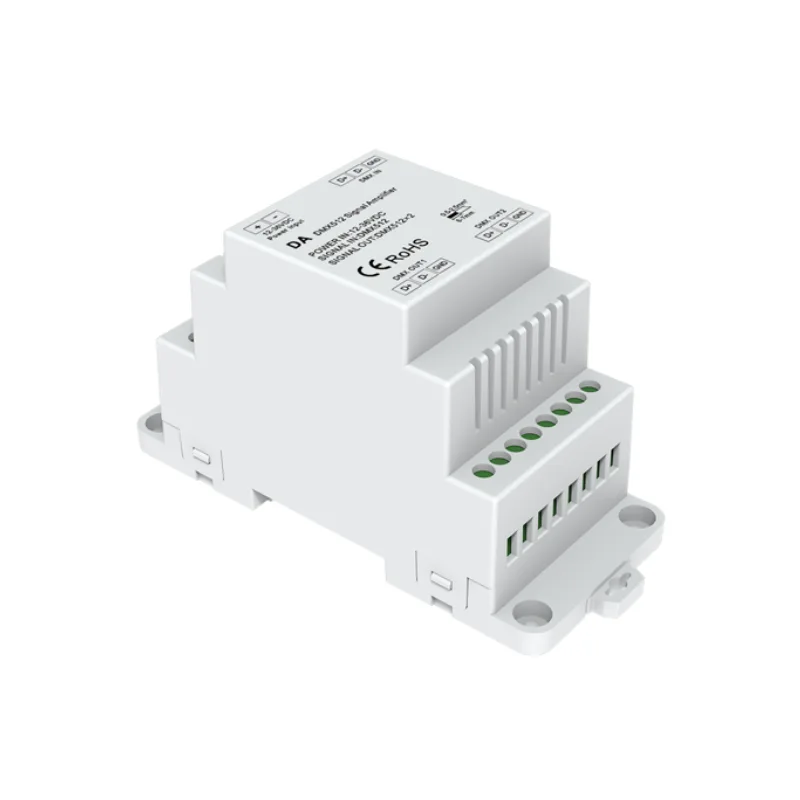
เครื่องขยายสัญญาณ DA DMX
● แอมพลิฟายเออร์สัญญาณ DMX 512 2 ช่อง
● อินพุตสัญญาณ DMX512 หนึ่งช่อง เอาต์พุตสัญญาณ DMX512 สองช่อง ทุ่มเทเพื่อขยาย กระจาย และป้องกันสัญญาณที่มาจากอุปกรณ์ระบบไฟ DMX เมื่อเชื่อมต่อกับบัสของ DMX512 (หรือ RS-485)
● ตระหนักถึงการขยายระยะการส่งสัญญาณ
● สัญญาณควบคุมการขยายสัญญาณ ขยาย DMX (485) สัญญาณเพื่อกระจายการควบคุมหลายช่องสัญญาณ
ราคา: 24.98 USD/PCS
จะกำหนดค่าแหล่งจ่ายไฟอย่างไร?
ระบบแถบนีออน LED DMX512 มักจะประกอบด้วยส่วนแสงหลายส่วน ซึ่งจำเป็นต้องสำรองระยะขอบตามกำลังโหลดทั้งหมดและการเปลี่ยนแปลงแบบไดนามิก
1. การคำนวณกำลังโหลดทั้งหมด: P รวม = ∑ (พลังงานส่วนแสงเดียว × ตัวเลข)
พลังงานส่วนแสงเดียว: DMX512 LED แถบนีออนต่อเมตรหรือต่อส่วน (เช่น 5 W/m)
ตัวอย่าง: มีเทปแสง 10 ส่วน แต่ละส่วน 3 เมตร โดยกำลังต่อเมตรที่ 8W รวม = 10 × 3 × 8 = 240 W
2. การคำนวณพลังงานพิกัด: พลังงาน = P รวม × (1 + ปัจจัยด้านความปลอดภัย) ÷ ประสิทธิภาพพลังงาน + P (คอนโทรลเลอร์ DMX)
ปัจจัยด้านความปลอดภัย: ขอแนะนำให้ใช้ 0.2 ~ 0.3 (ระบบ DMX อาจมีความผันผวนบ่อยครั้งและมีความผันผวนในปัจจุบัน)
ประสิทธิภาพการใช้พลังงาน: โดยปกติ 85% ~ 95% (แหล่งจ่ายไฟแบบสลับมีประสิทธิภาพมากกว่า)
การใช้พลังงานของคอนโทรลเลอร์ DMX: โดยปกติ 5 ~ 20 W (ต้องอ้างอิงถึงรุ่นเฉพาะ)
ตัวอย่าง:
โหลดทั้งหมด 240W, ปัจจัยด้านความปลอดภัย 0.3, ประสิทธิภาพการจ่ายไฟ 90%, การใช้พลังงานของคอนโทรลเลอร์ 15W:
แหล่งจ่ายไฟ = 240x1.3÷0.9+15≈303+15=362W
ควรเลือกแหล่งจ่ายไฟ≥ 360W
พาวเวอร์ซัพพลายแบรนด์ (เช่น ซีรี่ส์ XLG เฉลี่ยของหลุม) แนะนำให้ลดการรบกวนของสัญญาณและปัญหาแรงดันตก ให้แรงดันไฟฟ้าคงที่ (โดยปกติคือ DC12V หรือ 24V) เพื่อให้ตรงกับกำลังของแถบแสง (เช่น 12W/M@RGB)
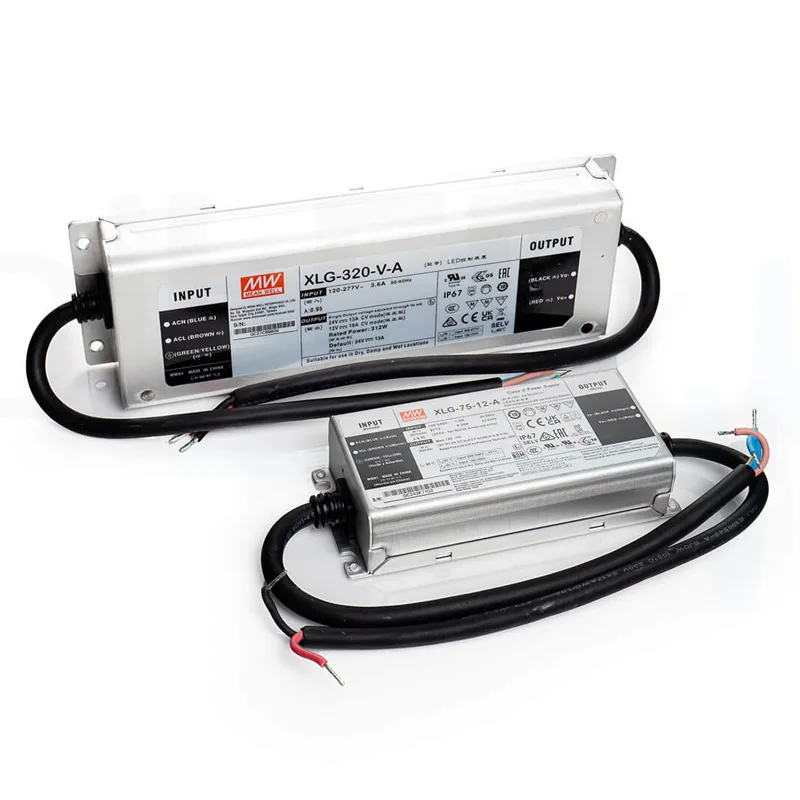
ค่าเฉลี่ย Well XLG Series IP67 แรงดันไฟฟ้าคงที่ LED แหล่งจ่ายไฟ
แรงดันตกคืออะไร?
พูดง่ายๆ แรงดันตก คือการสูญเสียพลังงานที่เกิดขึ้นระหว่างการไหลของแรงดันในวงจรเมื่อกระแสผ่านไฟ LED กระบวนการนี้คล้ายกับการไหลของน้ำผ่านท่อแคบ ๆ ความเร็วของน้ำจะเกิดจากการเสียดสีเพื่อทำให้เกิดการสูญเสียพลังงานจำนวนหนึ่ง สำหรับหลอดไฟ LED และโคมไฟ แรงดันตกจะทำให้เกิดกำลังไฟไม่เพียงพอ ส่งผลต่อประสิทธิภาพการส่องสว่างและอายุการใช้งานของหลอดไฟและโคมไฟ
ปัญหาแรงดันตกของแถบ LED คือเมื่อแถบ LED เชื่อมต่อกับแหล่งจ่ายไฟ เนื่องจากความยาวของวงจรและกระแสไฟขนาดเล็กที่เกิดจากการสูญเสียแรงดันไฟฟ้า ส่งผลให้ความสว่างของแถบ LED ไม่เพียงพอหรือไม่สม่ำเสมอ ปัญหานี้เป็นเรื่องยากมากสำหรับผู้ใช้ที่ใช้แถบไฟ LED มาเป็นเวลานานดังนั้นพวกเขาจึงต้องหาทางแก้ไข!
ไฟ LED แถบแรงดันตกทำให้เกิด:
- กระแสไฟที่เล็กลง: กระแสไฟ LED มักจะมีขนาดเล็ก โดยปกติระหว่าง 0.02 ถึง 0.03 A ส่งผลให้การสูญเสียแรงดันไฟฟ้าเกิดขึ้นแม้ในสายสั้นและมีความชัดเจนมากขึ้นสำหรับการใช้งานแบบสายยาว
- ความยาวเส้น: โดยทั่วไป ยิ่งความยาวของเส้นระหว่างไดรเวอร์กับแถบไฟ LED แถบยาวขึ้น ปัญหาแรงดันตกจะชัดเจนมากขึ้น
- ประเด็นด้านคุณภาพ: คุณภาพของแถบ LED อาจมีผลกระทบต่อปัญหาแรงดันตก แถบ LED คุณภาพต่ำบางแถบอาจมีปัญหาแรงดันตกเนื่องจากความต้านทานภายในที่มากเกินไปหรือไม่เพียงพอ ซึ่งสามารถเพิ่มความต้านทานของเส้นได้
วิธีการเลือกสายไฟสำหรับการติดตั้งแถบนีออน LED?
DMX512 ระบบแหล่งจ่ายไฟแรงดันต่ำ (12V/24V DC) กระแสไฟมีขนาดใหญ่ปัญหาแรงดันตกจะเด่นชัดเป็นพิเศษและคุณต้องแน่ใจว่าแรงดันไฟฟ้าสิ้นสุดมีเสถียรภาพ
เพื่อให้มั่นใจถึงความสม่ำเสมอของความสว่างของความสว่างก่อนและหลังลูกปัดหลอดไฟและหลีกเลี่ยงผลกระทบของแรงดันตกที่แถบแสงโดยปกติเราสามารถใช้วิธีการต่อไปนี้:
● เพิ่มเส้นผ่านศูนย์กลางลวด: ลดความต้านทานของเส้น (เส้นผ่านศูนย์กลางของเส้นลวดทั่วไป: 1.5mm², 2.5mm²)
● แหล่งจ่ายไฟแบบแบ่งส่วน: เมื่อเดินสายไฟในระยะทางไกล ให้แยกแหล่งจ่ายไฟออกเป็นหลายวงจร
● อัพเกรดแรงดันไฟ: หากแรงดันตกที่ปลายมีขนาดใหญ่เกินไป ให้ใช้แหล่งจ่ายไฟแรงดันที่สูงขึ้นเล็กน้อย (เช่น ออกแบบระบบ 24V แทน 12V)
เพื่อจัดการกับแรงดันตกคร่อมอย่างถูกต้อง แต่ก็ไม่ได้พึ่งพาตัวนำเพื่อเพิ่มเส้นผ่านศูนย์กลางของลวด ความจำเป็นที่จะต้องคำนึงถึงต้นทุนที่เพิ่มขึ้นและเหตุผลของการเดินสายไฟ เราสามารถเลือกขั้นตอนต่อไปนี้ได้อย่างถูกต้องเพื่อชดเชยปัญหาแรงดันตกเพิ่มเติม
ขั้นตอนที่ 1 คำนวณกระแสน้ำประปา
ระบบ DMX มักจะแบ่งออกเป็นวงจรควบคุมหลายวงจรซึ่งจำเป็นต้องคำนวณแยกกันสำหรับแต่ละวงจรโหลด:
i single = p single / v work
ตัวอย่าง: โหลดเดียว 3 ส่วนของแถบ (3m × 8 W/m × 3 ส่วน = 72 W) แรงดันไฟฟ้าในการทำงานคือ 24 V
i วงจรเดียว = 72/24 = 3.0A
ขั้นตอนที่ 2: คำนวณแรงดันตก
r=ρ×(2L/A)
ΔU=I วงจรเดี่ยว×R
พารามิเตอร์ที่สำคัญ:
ρ: ความต้านทานของลวดทองแดงที่ถ่ายเป็น 0.0172 Ω-mm²/m
L: ระยะทางทางเดียวจากแหล่งจ่ายไฟไปยังจุดสิ้นสุด (หน่วย: เมตร)
A: พื้นที่หน้าตัดของเส้นลวด (หน่วย: mm²)
2L: ความยาวรวมของเส้นทางไปกลับปัจจุบันคือ 2L
ตัวอย่าง:
กระแสไฟ 3A เส้นเดียว ความยาว 15 เมตร ใช้ลวดทองแดง 1.5mm²:
r = 0.0172 x (2 x 15/1.5) = 0.344 Ω
แรงดันตก: ΔU=3AX0.344Ω≈1.032VV
แรงดันไฟท้าย: 24V-1.032V=22.97V (แรงดันตกที่ 4.29% ตามข้อกำหนด ≤5%)
แรงดันตกที่อนุญาต: โดยปกติแล้วจะต้องไม่เกิน 5%-10% ของแรงดันไฟฟ้าในการทำงาน (แรงดันไฟ 12V ของระบบ ≤ 0.6-1.2V, ระบบ 24V ≤ 1.2-2.4V)
ข้อควรระวัง:
1. การแยกสัญญาณและแหล่งจ่ายไฟ: ขอแนะนำให้ใช้แหล่งจ่ายไฟอิสระ ขอแนะนำให้ใช้คอนโทรลเลอร์ DMX และแถบไฟ LED ให้ใช้แหล่งจ่ายไฟอิสระเพื่อหลีกเลี่ยงการรบกวน
2. ลวดป้องกัน: สายสัญญาณ DMX ต้องใช้ลวดป้องกันแบบบิดเกลียว (เช่น CAT5E) และรักษาระยะห่างมากกว่า 30 ซม. จากสายไฟ
3. กลยุทธ์การจ่ายไฟแบบแบ่งส่วน: เมื่อติดตั้งในระยะทางไกล ให้ตั้งค่าจุดจ่ายไฟทุกๆ 20-30 เมตรเพื่อลดแรงดันไฟวงจรเดียว
4. การซิงโครไนซ์พลังงาน: เมื่อเชื่อมต่ออุปกรณ์จ่ายไฟหลายตัวแบบขนาน ให้ตรวจสอบพื้นทั่วไปหรือใช้โมดูลการซิงโครไนซ์เพื่อหลีกเลี่ยงความแตกต่างที่อาจเกิดขึ้นซึ่งรบกวนสัญญาณ DMX
5. การวัดแรงดันไฟท้าย: ใช้มัลติมิเตอร์เพื่อยืนยันว่าแรงดันไฟท้ายคือ≥90% ของแรงดันไฟฟ้าที่กำหนด
6. การทดสอบความเสถียรของสัญญาณ: ตรวจสอบว่าสัญญาณ DMX กะพริบหรือสูญเสียแพ็กเก็ตเนื่องจากการรบกวนของพลังงาน
7 . การทดสอบอุณหภูมิเพิ่มขึ้น: หลังจากทำงานเต็มโหลด 1 ชั่วโมงอุณหภูมิพื้นผิวของแหล่งจ่ายไฟควรเป็น ≤60 ℃
สำหรับการติดตั้งกลางแจ้ง โปรดดูที่โพสต์: โซลูชั่นการติดตั้งนีออนแบบยืดหยุ่นสำหรับสถาปนิกและผู้ติดตั้ง.
สรุป
DMX ควบคุม พา นกัลป์ ได้กลายเป็นตัวเลือกในอุดมคติสำหรับโครงการแสงทางสถาปัตยกรรมด้วยโปรโตคอลที่ได้มาตรฐานและความสามารถในการป้องกันการรบกวนในระดับสูง
เทคโนโลยีนี้สามารถควบคุมแสงได้อย่างแม่นยำผ่านโปรโตคอล DMX512 รองรับการส่งสัญญาณทางไกล (สูงถึงหลายร้อยเมตร) และการซิงโครไนซ์แบบหลายโหนดและสามารถปรับความสว่างสีและเอฟเฟกต์แบบไดนามิกได้อย่างยืดหยุ่นซึ่งเหมาะสำหรับการตกแต่งอาคาร แสงแนวนอน และสถานการณ์อื่น ๆ
ใช้เทคโนโลยีการส่งสัญญาณที่แตกต่างกันเพื่อหลีกเลี่ยงการรบกวนทางแม่เหล็กไฟฟ้าอย่างมีประสิทธิภาพและรองรับฟังก์ชั่นการส่งเบรกพอยต์เพื่อเพิ่มเสถียรภาพของระบบ การใช้งานจริงจำเป็นต้องให้ความสนใจกับการตั้งค่าที่อยู่และการวางแผนสาย เช่น การใช้ตัวแก้ไขที่อยู่ DMX512 เพื่อกำหนดค่าที่อยู่ของหลอดไฟและโคมไฟ และผ่านตัวควบคุม (เช่น แพลตฟอร์ม IoT โต้ตอบ) เพื่อให้เกิดการจัดการแบบรวมศูนย์และเพิ่มประสิทธิภาพการใช้พลังงานและการบำรุงรักษา
รวมกับการควบคุมการลดแสงและการแบ่งเขตอัจฉริยะ DMX512 LED ระบบไฟนีออนสามารถควบคุมได้อย่างแม่นยำและแม้กระทั่งความสว่างผ่านการออกแบบที่เหมาะสมในขณะที่มั่นใจในการใช้งานในระยะยาว
